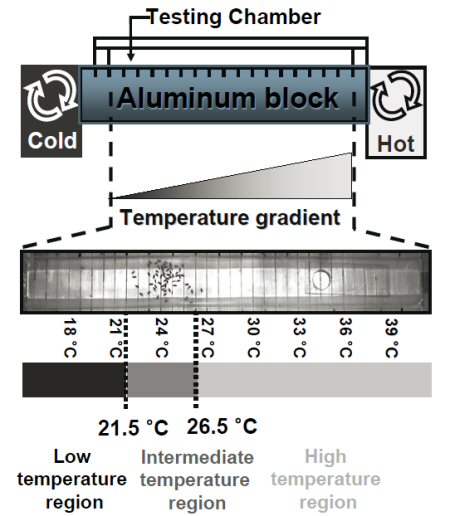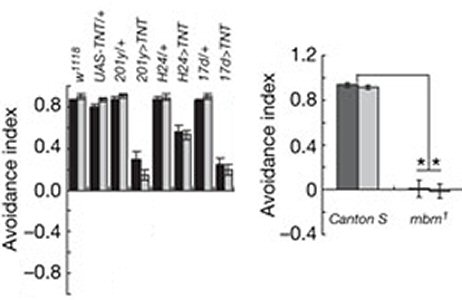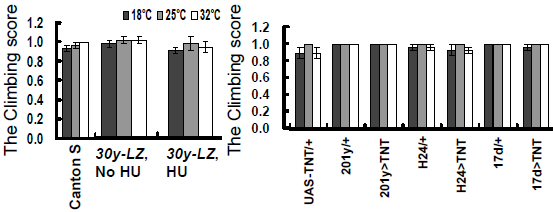Main Menu
Welcome
The authors went through unbelievable efforts to test an enormous number of different wild type, mutant and transgenic Drosophila strains for their temperature preference. Based on only 8 authors, it seems to me these authors must have worked 24/7 for many, many months to get all this data, evaluate them and discuss and compile all the results. Here's their experiment:

Pretty self explanatory: the flies walk around in a chamber with a temperature gradient and where they spend most of their time determines their temperature preference. From this sort of data, the authors calculate a preference index for high or low temperatures, respectively:

According to their graph, flies walking around incessantly score an AI of zero both for high temperatures and for low temperatures (center pane of the graph). There is a structure in the Drosophila brain that is associated with hyperactivity: the mushroom-bodies. The study was published exactly ten years before Hong et al.: Mushroom bodies suppress locomotor activity in Drosophila melanogaster. Apparently, the authors are unaware of this publication, as they don't even cite it. However, the authors of this previous paper have used a very similar setup (horizontal tubes) and tested flies for their walking activity:

In this graph (Fig. 2 from Martin et al., 1998), the mutant mbm1 as well as transgenic fly strains which have synaptic activity blocked in various parts of the mushroom-bodies (line 201Y, H24 and 17D) show increased walking activity. Now let's see how these flies perform in the temperature assay from Hong et al. (Fig. 1, modified to show just selected strains):

As expected, the flies show an AI of around zero (with black bars denoting AI low and grey bars AI high). But Hong at al. have not suspended critical thought entirely before they submitted the results of their intensely laborious screening efforts. They realized there was a need to control for some sort of locomotion defects in the flies they tested. However, their control also fails on several levels: a) they used a climbing assay when in their temperature assay the flies were walking horizontally and b) the climbing performance in their assay could only decline and not increase:

Thus, the authors could not detect the increase in walking performance that inhibiting mushroom-body function conveys (Martin at al., 1998).
In summary: Hong et al. conclude that the mushroom-bodies are involved in temperature preference by using a locomotor assay that reproduces the results of an experiment published ten years earlier (Martin et al. 1998). Somehow adding insult to injury, they tested an absolutely incredible number of fly strains (more than 120, by my count), yielding no less than 30 pages of supplementary material with many figures, tables, text and references (but again, no citation of Martin et al. 1998 in there). Yet, they only manage to show the same thing as Martin et al. in 1998 with 10% the number of strains.
Important: Of course, all this does not exclude that the mushroom-bodies and the processes in the neurons there controlling cAMP level indeed may be involved in temperature sensing and temperature preference. It's only that Hong et al. haven't shown that, yet.
References:
Hong, S., Bang, S., Hyun, S., Kang, J., Jeong, K., Paik, D., Chung, J., & Kim, J. (2008). cAMP signalling in mushroom bodies modulates temperature preference behaviour in Drosophila Nature DOI: 10.1038/nature07090
1. Jean-René Martin, 2. Roman Ernst, & 3. Martin Heisenberg (1998). Mushroom Bodies Suppress Locomotor Activity in Drosophila melanogaster Learning and Memory, 5, 179-191 DOI: 10.1101/lm.5.1.179
Posted on Sunday 17 May 2009 - 16:21:01 comment: 0
{TAGS}
{TAGS}
You must be logged in to make comments on this site - please log in, or if you are not registered click here to signup
Render time: 0.2117 sec, 0.0063 of that for queries.





